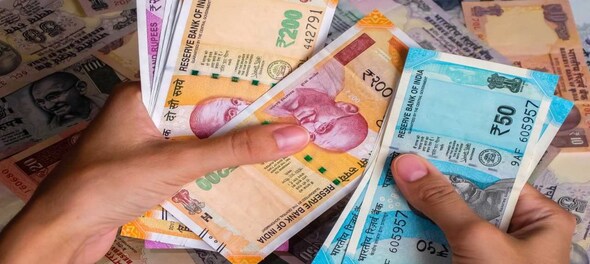
Delhi Chief Minister Arvind Kejriwal stoked a controversy with his remarks that images of Goddess Lakshmi and Lord Ganesha should be on currency notes for the "prosperity" of the country. Earlier in the day, senior Congress leader Manish Tewari batted for Dr BR Ambedkar's photograph on currency notes along with Mahatma Gandhi.
Claiming that the Indian economy was not in good shape, Kejriwal said at a press conference the country needed a lot of effort to get the economy back on track along with the "blessings of our gods and goddesses".
As leaders across political parties suggest including photographs of gods and icons on the currency notes, you might wonder if that could become a reality. Here is all you need to know:
Who decides on the figure to be printed on a new banknote?
As per Section 25 of the Reserve Bank of India (RBI) Act, the central government approves the design, form, and material of bank notes following recommendations made by Central Board. The RBI's Central Board and the Central government has to approve any change in the design of a currency note. Changes in the design of coins are the prerogative of the central government.
The RBI has the sole right to issue banknotes in India, according to Section 22 of the Act.
Where are banknotes and coins produced/minted?
Bank notes are printed at four currency presses -- two of which are owned by the Centre through its Corporation, Security Printing and Minting Corporation of India Ltd. (SPMCIL) and two are owned by the RBI, through its wholly owned subsidiary, Bharatiya Reserve Bank Note Mudran Private Ltd (BRBNMPL).
Coins are minted in four mints owned by SPMCIL -- Mumbai, Hyderabad, Kolkata and Noida.
What is currency paper made up of?
The currency paper currently being used is made using 100 percent cotton.
What are the various types of banknotes issued since independence?
There are four types of banknotes being issued since independence. The details are as follows:
Ashoka Pillar banknotes:
The first banknote issued by independent India was the Re 1 note in 1949. While retaining the same designs, the new banknotes were issued with the symbol of the Lion Capital of Ashoka Pillar at Sarnath in the watermark window in place of the portrait of King George.
The name of the issuer, the denomination, and the guarantee clause was printed in Hindi on the new banknotes from 1951. Three years later, banknotes in the denomination of Rs 1000, Rs 5,000 and Rs 10,000 were issued in 1954.
Banknotes in Rs 10 denomination were issued between 1967 and 1992, Rs 20 denomination in 1972 and 1975, Rs 50 in 1975 and 1981, and Rs 100 between 1967 and 1979. In the year 1970, banknotes with the legend "Satyameva Jayate" were introduced. In October 1987, Rs 500 banknote was introduced with the portrait of Mahatma Gandhi and the Ashoka Pillar watermark.
Mahatma Gandhi (MG) Series 1996
The banknotes of this series bear the portrait of Mahatma Gandhi on the obverse (front) side, and the symbol of the Lion Capital of Ashoka Pillar was shifted to the left side next to the watermark window. This means that these banknotes contain the Mahatma Gandhi watermark as well as Mahatma Gandhi's portrait.
Mahatma Gandhi series – 2005 banknotes
These banknotes were issued in the denomination of Rs 10, Rs 20, Rs 50, Rs 100, Rs 500 and Rs 1,000 and contained some additional/new security features as compared to the 1996 MG series. The legal tender of banknotes of Rs 500 and Rs 1,000 of this series was withdrawn with effect from midnight of November 8, 2016.
Mahatma Gandhi (New) Series (MGNS) – November 2016
The Mahatma Gandhi (New) Series, introduced in 2016, are more wallet-friendly, being of reduced dimensions and hence expected to incur less wear and tear. For the first time, designs for banknotes have been indigenously developed on themes reflecting the diverse history, culture and ethos of the country.
The first banknote from the new series was introduced on November 8, 2016, and is a new denomination, Rs 2000-with, the theme of Mangalyaan. Subsequently, banknotes in this series in denominations of Rs 500, Rs 200, Rs 100, Rs 50, Rs 20 and Rs 10 have also been introduced.
What happens to the old-design banknotes when a new design is introduced?
Both old and new design notes usually circulate together for a while. The old design notes are then gradually withdrawn from circulation when they become unfit to be re-issued.
Check out our in-depth Market Coverage, Business News & get real-time Stock Market Updates on CNBC-TV18. Also, Watch our channels CNBC-TV18, CNBC Awaaz and CNBC Bajar Live on-the-go!


Lok Sabha elections 2024: From Wayanad to Shivamogga, key battles in the second phase
Apr 25, 2024 2:01 PM
EC probes allegations of MCC violation by Modi, Rahul; seeks response by April 29
Apr 25, 2024 1:32 PM
LS polls phase 2: Rahul Gandhi, Shashi Tharoor in fray; Hema Malini, Om Birla eyeing hat-trick
Apr 25, 2024 12:19 PM
UP constituencies to witness three-cornered fight in second phase tomorrow
Apr 25, 2024 10:47 AM

